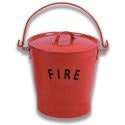Ash Removal Safety Tips, October 1, 2019 by Katie Graham

Ash Removal Safety Tips
Each year, Boulder Creek Fire responds to fires that are caused by improper disposal of hot coals or ashes from fireplaces, wood stoves, pellet stoves, grills or mobile fireplaces designed for use on decks or patios.
The fact is that coals and ashes from fires can remain hot enough to start a fire for many days after you think the fire is out. The exact amount of time for complete extinguishment and cooling depends on many factors such as how hot the fire was, what was burning, how much unburned fuel remains, etc.
To be safe, simply treat all ashes and coals as hot, even when you think they had time enough to cool. Please consider these following ash removal safety tips:
- If possible, allow ashes and coals to cool in the area where you had the fire for several days. These devices are designed to contain their heat safely.
- When it is time to dispose of the ashes, transfer them to a metal container and wet them down. Keep the container at least 10 feet away from the home, other buildings and anything flammable. They should NEVER be disposed of in a plastic garbage box or can, a cardboard box, or paper grocery bag. Never use a vacuum cleaner to pick up ashes.
- After sitting for a week in the metal container, check them again to be sure that they are cool. If so, the ashes are then safe to dispose of in your trash.
More Fireplace Safety Tips
- Have heating equipment, chimney and stove inspected and cleaned by a certified chimney sweep every fall just before heating season.
- Have your chimney inspected annually, and cleaned as necessary, by a professional chimney sweep to ensure it is clear of obstructions and creosote.
- Repair any cracks in your chimney and fireplace.
- Use fireplace screens to keep sparks and fire debris inside the fireplace.
- Do not use an accelerant to start a fire.
- Ensure the fire is completely out before going to bed or leaving the house.
- Keep all children and pets a safe distance from fireplaces.
- Install both smoke and carbon monoxide alarms.
- Keep a fire extinguisher on hand.
- Observe all safety precautions when using outdoor fireplaces they can be just as dangerous as indoor units.
- As a safety precaution keep anything that can burn at least three feet away from a fireplace, wood stove, or any other heating appliance, and create a three-foot “kid-free zone” around open fires.
- Never leave a fire unattended, particularly when children are present.
